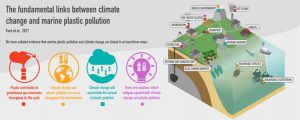
polympart: Despite being frequently described as separate and even competing issues, the climate crisis and plastic pollution are more linked than we used to think, a new study found. Researchers called for governments and policymakers to urgently tackle the two issues together so as to avoid falling short on much-needed solutions.
For the first time, an interdisciplinary team of scientists collected evidence on how both global problems exacerbate one another, creating a dangerous cycle. The researchers identified three significant ways that the climate change crisis and marine plastic pollution are connected.
Most plastic production is supported by fossil fuel extraction and the consumption of limited resources, contributing to global greenhouse gas emissions. That’s also the case of plastic waste, which is either burned or deposited in landfills. While plastic alternatives are expected to increase in production, their carbon footprint is yet unclear.
Climate change is also an influential factor in the distribution of plastic pollution, something that will increase even further as extreme weather expands. At the same time, global warming has already proven to have catastrophic consequences for the marine environment, which happens simultaneously with the impacts of plastic pollution.
The plastic-climate link
Plastic production went from two million metric tons in 1950 to about 380 million in 2015, meaning an annual growth of 8.4%. This has been driven by the need for cheap and lightweight materials in our day-to-day lives. However, the demand for plastics is set to continue as economies expand, which is very bad news for the environment.

About 56 billion metric tons of carbon dioxide equivalent in greenhouse gases would be released between 2015 and 2050 because of plastic production . This is 10% of the remaining carbon budget. Only in 2015, plastic production released the equivalent of more than a billion metric tons of CO2, which equals 3% of fossil fuel emissions.
But it’s not all about emissions. Microplastics have gradually become a global problem, as they are transported through the atmosphere and can reach very remote areas. Climate change is expected to further impact plastic pollution fluxes and concentrations in its global distribution, driven mainly by extreme weather events.
Marine plastic pollution, alongside climate change impacts, affects ecosystems that are vulnerable to climate change. This is especially concerning for vulnerable and remote environments that haven’t been affected much in the past. Let’s take the polar regions as an example, a pristine environment now with plenty of microplastics accumulated.
A joint solution
For the researchers, the scale of the societal, economic, and commercial shift needed to avoid the worsening impacts of the climate and plastic pollution crises, requires both a top-down and bottom-up approach. Global and national economies should shift to a circular economy by decoupling growth from the use of finite resources.
But this will be tricky, as the global society has become less circular over the past two years. That’s why a re-emphasis of the importance of reducing or reusing plastic and plastics is needed to reduce our reliance on single-use products. If growth in single-use plastic continues, it could account for 5 to 10% of global GHG emissions by 2050.
source: https://www.zmescience.com

